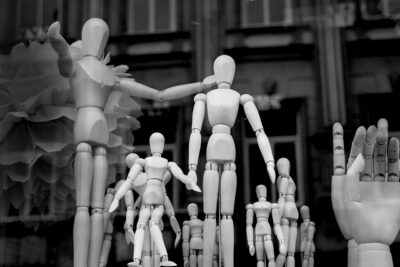 Your story idea is well underway, and the characters are firmly set in your mind. Yikes! They’re all naked! Unless your story takes place in a nudist colony, you’ll need to clothe those bodies, and quick!
Your story idea is well underway, and the characters are firmly set in your mind. Yikes! They’re all naked! Unless your story takes place in a nudist colony, you’ll need to clothe those bodies, and quick!
When and What?
When your story takes place has a significant bearing on what your characters wear. You won’t dress a medieval peasant woman in a flowing gown of silk or velvet when they would be wearing linen or wool. They couldn’t afford it, even though it was available. If someone wears that beautiful gown, don’t say that it’s a jacquard pattern because that process wasn’t invented until 1801. Some readers may not catch the error or be concerned, but others will call you out, lessening the authenticity of your story.
If your characters are set in a fantasy world (and it’s not nudist), you’ll need to create garments and clothe them as well. Do the garments establish rank and/or occupation? Do they change color when exposed to the sun? What about at night? Do they glow? Once you establish the basic guidelines, you can have fun with the details.
Undergarments?
Are undergarments worn in the time period your story is set? What about corsets? They were introduced in France in the 1500s, so any female character prior to that time would be safe from that confining bodice contraption your female characters (beginning around age 15) might have to wear from then until the early 1900s!
No boxers, briefs, or panties for your medieval characters! Medieval men wore loose drawers referred to as breeks or breeches, and women wore a smock or chemise and no pants. Your readers may never see these undergarments, but they may figure into the plot of your story. If your character (or someone else!) is fumbling with or pulling at a character’s clothes, the reader needs to know that what’s underneath is authentic to the time period of your story.
Fantasy underwear? Does it exist to serve a purpose (other than what a reader might think) in your fantasy world? Does it do more than cover or protect the wearer’s body? Perhaps it signals when a woman is ovulating. Signals who? As the writer, you can have fun creating the otherworldly garments, but they have to be logical, have a purpose, and be believable to the reader.
Fun With Details!
Once your characters are clothed, it might be fun to add something that might/might not be caught by your readers. The literary world calls them Easter Eggs–an extra layer to an object, action, piece of dialogue or a character in a story that may be hidden to many readers. You can have fun with this, and see if your readers will discover it/them.
One example (because we’re talking about clothing) would to simply have a garment be a specific color that conveys meaning for the time period. The color purple has come to symbolize royalty and was kept for the elite because of the rarity and cost of the dye. Today? Not so much, so be aware of the time period and location of where you’re using color. In many Western cultures, orange is often used for fun, strength, courage, and creativity. But also notable is that orange is used for high visibility (traffic cones, space suits, etc.) because it contrasts strongly with the color blue (easy to spot against a clear sky). White was used for wedding gowns beginning around 1840 (Queen Victoria ushered in the tradition), but red or gold is what a Chinese bride will wear (white is their symbol of mourning).
Perhaps your character will wear a piece of jewelry that carries a hidden meaning or message. What does it mean? Who is meant to receive the message? Will anyone else find out? What happens then?
Author Stephen King uses Easter eggs, often linking characters and places from one book to the next. Margaret Atwood left some graffiti that is etched into a desk for fans to discover.
Here’s an idea. What if the fabric woven into a piece of clothing had a symbolic item as part of the pattern? The Victorian Era was big on the symbolism of flowers, using them as a sort of silent dialogue. White clover would ask the observer to think of me. Red roses symbolized love, while yellow ones conveyed jealousy or infidelity. Clearly, one had to be careful when choosing fabrics that had a wordless, powerful story of their own to tell.
There’s a lot that goes into getting those naked bodies covered! Once that basic task is complete, there are infinite possibilities for you (the writer) to enhance the lives of your characters with hushed, quiet details and enrich your story for you and your readers.

Niki Kantzios
Thanks for this. What a fun and important advice! Fantasy underwear sort of exploded my head!
VERONICA H HART
I always enjoy reading your column. Just last week, I submitted a passage for critique from my latest novel. The woman in question had just murdered someone and washed her clothes while she showered. I wrote about the very bloodied dress but neglected to mention underwear. Critiquers quickly pointed that out.
Lee Gramling
Good food for thought. Many years ago I took a course in theatre costuming and still have the tracings that all of us were compelled to make. I later found some booklets with reproductions of 1890s paper dolls, which are invaluable in showing clothing of the era (including underwear!). There’s nothing like seeing it for yourself before trying to describe it.
Ken Pelham
Entertaining and informative column! There’s no substitute for research, is there?